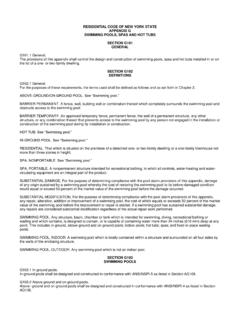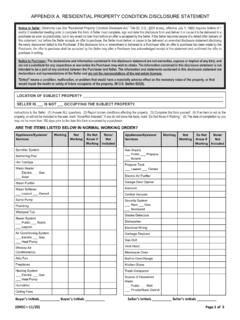Transcription of Internal Revenue Service
1 Internal Revenue ServiceDepartment of the TreasuryWashington, DC 20224 Number: 201809003 Release Date: 3/2/2018 Index Number: Re: Request for rulings under IRC 25 DThird Party Communication: NoneDate of Communication: Not ApplicablePerson To Contact:------------------------, ID No. ----------------Telephone Number:----------------------Refer Reply To:CC:PSI:B06 PLR-118431-17 Date: November 27, 2017 Legend:State=--------------Year 1=-------Year 2=-------Date 1 =----------------------Director=-------- ---------------------------------------- ------------Dear -------------------------:This letter is in response to your letter dated June 9, 2017, and subsequent correspondence dated September 21, 2017, submitted by your authorized representatives, requesting rulings under 25D of the Internal Revenue code ( code ).
2 Specifically, you request a letter ruling that the cost of installing certain energy storage property to be integrated into other residential solar photovoltaic system property will qualify as a qualified solar electric property expenditure eligible for the tax credit under facts and representations submitted are as follows:You are married individuals who reside in State and file joint federal income tax returns. You use the cash method of accounting and are a calendar year Year 1, you purchased from an installer a system of components which you collectively refer to as a Solar Energy System and each component of which you refer to as a Solar Energy System Component.
3 You acquired the Solar Energy System to use solar energy to generate electricity for use in your dwelling unit which you use as a residence. The Solar Energy System was interconnected into the electrical grid of the local utility and installation was considered to be complete for purposes of 25D(e)(8)(A) of the code on Date 1. The associated costs of the Solar Energy System met the requirements for qualified solar electric property expenditures under 25D(d)(2). Accordingly, you claimed a tax credit under 25D equal to 30 percent of PLR-118431-172the costs of the Solar Energy System property in Year 1, the year in which the installation of the property was are purchasing an energy storage product from an installer that can be integrated into existing Solar Energy Systems as an additional Solar Energy System product is comprised of 1) an AC battery; 2) an inverter that will convert solar electricity between AC and DC so the battery can charge and discharge the solar electricity.
4 3) required wiring to interconnect the product into your current Solar Energy System Components and your dwelling unit; and 4) a software management tool that will monitor and control the charging and discharging of energy (collectively, the Battery ). You represent that the Battery is AC coupled to any new or existing Solar Energy System. The Battery contains a meter with current transformers that monitor the solar production and grid import as well as Internal meters within the Battery that monitor charge and discharge power. When the Battery is constrained to charge only from solar, the software monitors these signals (every seconds) and controls the Battery such that charging only occurs when the Solar Energy System is producingenergy and only up to the instantaneous solar power.
5 Thus all energy that is used to charge the Battery can be effectively assured to come from the Solar Energy System. Your purchase price for the Battery will include the labor costs allocable to onsitepreparation, assembly, and original installation of the Battery. You intend for the original installation of the Battery to be completed in Year 2. The Battery is expected to have a storage capacity of kilowatt hours ( kWh ) and a power rating of 5kilowatts ( kW ).Software controls will ensure your Battery will store solar electricity generated by the PV Panel and use it a later point in time either later in the day or at night. In addition, integrating the Battery into the other Solar Energy System Components will enable you to disconnect from the grid in the event of a grid outage and continue using solar electricity in compliance with electrical codes when other Solar Energy Systems without a Battery will be forced to cease operating.
6 The remaining useful life of your Solar Energy System is expected to exceed the useful life of the Battery and, much like a typical inverter, the Battery will likely need to be replaced at some point during the remaining useful life of the Solar Energy the reasons set forth in this letter ruling request, you request that the Internal Revenue Service rule on the following issues:1)Whether the Battery will be considered a qualified solar electric property expenditure within the meaning of 25D(d)(2) of the code when installed as a component part of a Solar Energy System to solely function as an energy storage device and use solar energy, and, therefore, a tax credit under 25D may be claimed on its full ) Whether the Battery cost remains a qualified solar electric property expenditure when installed in a taxable year after the taxable year in which the installation of your other Solar Energy System Components are and AnalysisSection 25D(a)(1)
7 Of the code allows an individual a credit against the income tax imposed for the taxable year in an amount equal to the applicable percentage of the qualified solar electric property expenditures made by the taxpayer during 25D(a)(2) of the code allows an individual a credit against the income tax imposed for the taxable year in an amount equal to the applicable percentage of the qualified solar water heating property expenditures made by the taxpayer during such 25D(d)(1) of the code defines the term qualified solarwater heating property expenditure as an expenditure for property to heat water for use in a dwelling unit located in the United States and used as a residence by the taxpayer if at least half of the energy used by such property for such purpose is derived from the 25D(d)(2) of the code defines the term qualified solar electric property expenditure as an expenditure for property which uses solar energy to generate electricity for use in a dwelling unit located in the United States and used as a residence by the 25D(e)(1)
8 Of the code allows the expenditures for labor costs properly allocable to the onsite preparation, assembly, or original installation of the qualified solar electric property and for piping or wiring to interconnect such property to the dwelling unit to be taken into account for purposes of section 25D(e)(3) of the code provides that expenditures which are properly allocable to a swimming pool, hot tub , or any other energy storage medium which has a function other than the function of such storage shall not be taken into account for purposes of this 25D(e)(8)(A) of the code , generally, for purposes of determining the tax year when the credit is allowed, an expenditure with respect to an item shall be treated as made when the original installation of the item is completed.
9 Under 25D(e)(8)(B), in the case of an expenditure in connection with the construction or reconstruction of a structure, such expenditure shall be treated as made when the original use of the constructed or reconstructed structure by the taxpayer 25D(g) of the code provides that for 25D(a)(1) and (2), the applicable percentage shall be 30 percent in the case of property placed in Service after December31, 2016, and before January 1, 2020. We conclude that this Battery meets the definition of a qualified solar electric property expenditure under 25D(d)(2) of theCode, and therefore, you may claim a tax credit on this Battery. The Battery is considered to be property which uses solar energy to generate electricity for use in your dwelling unit located in the United States and used as a residence by you.
10 The software management tool portion is only considered part of the qualified solar electric property so long as it is required in monitoring the charging and discharging of solar energy. Additionally, as provided by 25D(e)(1), labor costs that are properly allocable to the onsite preparation, assembly, or original installation of the Battery and for piping or wiring to interconnect the Battery to your home are eligible for the credit. Because under the statute, expenditures that are treated as made in Year 2 provide for a 30 percent tax credit, the applicable percentage in the case of your request is 30 representation that all energy that is used to charge the Battery can be effectively assured to come from the Solar Energy System is essential for this ruling.













